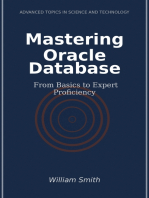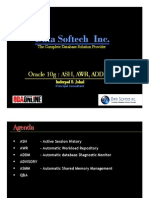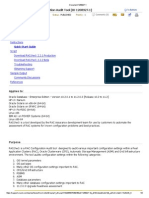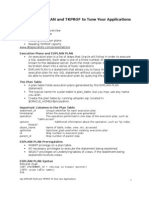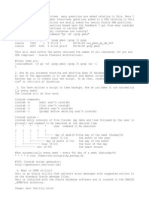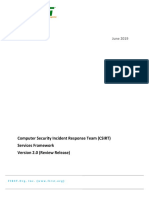ORACLE 11g SQL PL/SQL Performance Enhancements Developers
Uploaded by
Nikos PlevrisORACLE 11g SQL PL/SQL Performance Enhancements Developers
Uploaded by
Nikos Plevris<Insert Picture Here>
11g new performance features for Developers
A Knowledge Transfer session
Nikos Plevris, Principal Service Delivery Manager , November 2009
New performance features for Developers
Agenda
• SQL and PL/SQL performance improvement and scalability
• New and Enhanced
• Functionality
• Structures
• Objects
• The Developer’s approach
New performance features for Developers
Automatic “Native” PL/SQL Compilation
• Previous releases: PL/SQL interpreted to C code, 20% improved performance
then compiled by 3rd party compiler or DLL loader With native PL/SQL compilation:
• 11g: PL/SQL source code is directly translated to The Whetstone Benchmark shows
that real native compilation is
the DLL for the server, bypassing the file system two-and-a-half times faster than
directories by doing the linking and loading itself. C native compilation.
• Initialization parameter: plsql_code_type
• [NATIVE | INTERPRETED]
• Dynamic change:
• alter system | alter session
• alter procedure <PROC> compile
plsql_code_type=native;
• DBA_PLSQL_OBJECT_SETTINGS view
New performance features for Developers
Adaptive Cursor Sharing1
• Parameter cursor_sharing := [EXACT|
SIMILAR|FORCE]
• Bind peeking – Optimizer evolves execution
plan during first hard parse of bind variables
• 11g adaptive cursor sharing – Optimizer
generates multiple execution plans for a
statement that uses bind variables
New performance features for Developers
Adaptive Cursor Sharing2
• Allows for intelligent cursor sharing for
statements that use bind variables
• Is used to compromise between cursor sharing
and optimization
• Has the following benefits:
• Automatically detects when different executions
would benefit from different plans
• The optimizer avoids expensive table scans and
index searches based on selectivity criteria thus
speeding up data retrieval
• Automated mechanism that cannot be turned
off
New performance features for Developers
Adaptive Cursor Sharing3 - Architecture
New performance features for Developers
Adaptive Cursor Sharing4 – Dictionary Views
New performance features for Developers
Adaptive Cursor Sharing Demo
New performance features for Developers
SQL Query Result Cache1
200% improved performance for
• Cache the result of a query or query block for read-intensive workload
future use (SQL query and PL/SQL function Part of SGA shared pool
results) (~1% of shared_pool_size up to 75%)
or
• Cache is used across sessions and statements (0.25% of memory_target) or
(0.50% of sga_target)
unless it is stale
• Benefits:
• Scalability
• Reduction of memory usage and I/O
• Good candidate statements:
• Access many rows
• Return few rows
New performance features for Developers
Setting Up SQL Query Result Cache2
Three new init parameters
• At the instance level using parameter result_cache_mode
RESULT_CACHE_MODE. Values are: result_cache_max_size
result_cache_max_result
• AUTO: The optimizer decides to cache based Dynamic parameters:
on repetitive executions ALTER SYSTEM SET
• MANUAL: Use hint result_cache result_cache_mode = ‘AUTO’;
• FORCE: All results are stored in the cache
• At table level:
New performance features for Developers
Setting Up SQL query result cache3
Using the hint
• At the session level:
• ALTER SESSION SET result_cache_mode=FORCE;
• At the statement level – Queries, subqueries
and inline views:
• Hints result_cache_mode and
no_result_cache
PL/SQL code
New performance features for Developers
Administer SQL query result cache4
• Use DBMS_RESULT_CACHE package:
• View SQL Query cache dictionary information:
New performance features for Developers
Result Query Cache Demo
New performance features for Developers
Considerations on query result cache5
• The result cache is disabled for queries
containing:
• Result cache does not release memory:
• Bind variables:
New performance features for Developers
CREATE TABLE seq_table
(sequencing_id NUMBER);
Sequences in PLSQL CREATE SEQUENCE sequencing_s1;
-- In Oracle 10g you would use a
sequence value in a PL/SQL block
as follows:
• Sequence calls directly into statements without DECLARE
first querying them from the dual pseudotable sequence_value NUMBER;
BEGIN
• In 11g, the usage of the pseudocolumns SELECT sequencing_s1.nextval
CURRVAL and NEXTVAL make writing INTO sequence_value FROM
dual;
PL/SQL source code easier and improve run- INSERT INTO seq_table
time performance and scalability. VALUES (sequence_value);
COMMIT;
• The usage of sequence_name.CURRVAL and END;
sequence_name.NEXTVAL can be utilized /
whenever a number expression is used. --While this syntax still works in
Oracle 11g, you can now simplify
it by using:
BEGIN
INSERT INTO seq_table
VALUES
(sequencing_s1.nextval);
COMMIT;
END;
/
New performance features for Developers
Next-Generation LOBs create table secure_docs
( document_id number not null
• 11g provides two storage implementations primary key,
for LOB columns: name varchar2(255) not null,
• BASICFILE = Pre-Oracle 11g CLOBs, BLOBs edba_knowledgebase_category_id
number not null,
• SECUREFILE = New LOB storage mime_type varchar2(128),
implementation
doc_size number,
• Prerequisites dad_charset varchar2(128),
• automatic segment space management last_updated date,
(compatible 11.0.0.0.0) content_type varchar2(128),
• Benefits blob_content blob)
• Faster LOB Retrieval tablespace tools
• ODP.NET now makes fewer round trips to the lob (blob_content) store as
database server to retrieve LOB information. securefile (
ODP.NET LOB retrieval performance is now faster
• Queries in SQL*Plus now support BLOB columns. tablespace tools enable storage in
row chunk 8192 pctversion 10
• Reduce space consumption nocache logging)
• Enhanced Security
New performance features for Developers
CREATE [OR REPLACE] TRIGGER
trigger_name
Compound trigger 1 FOR {INSERT | UPDATE | UPDATE OF column1
[, column2 [, column(n+1)]] | DELETE}
ON table_name
COMPOUND TRIGGER
[declaration_statement;]
• Easier to program one trigger to fire at various timing
points instead of multiple simple triggers each fires BEFORE STATEMENT IS
[declaration_statement;]
at single timing point. BEGIN
• Has a section for each of the BEFORE execution_statement;
END BEFORE STATEMENT;
STATEMENT, BEFORE EACH ROW, AFTER EACH
BEFORE EACH ROW IS
ROW, and AFTER STATEMENT timing points. [declaration_statement;]
• Improved usability for the PL/SQL programmer and BEGIN
execution_statement;
improved runtime performance and scalability: END BEFORE EACH ROW;
• accumulate rows destined for a second table so that AFTER EACH ROW IS
you can periodically bulk-insert them [declaration_statement;]
BEGIN
• To avoid the mutating-table error (ORA-04091) execution_statement;
END AFTER EACH ROW;
• Can be defined on either a table or a view
• Only DML statements trigger compound triggers AFTER STATEMENT IS
[declaration_statement;]
BEGIN
execution_statement;
END AFTER STATEMENT;
END [trigger_name];
/
New performance features for Developers
CREATE [OR REPLACE] TRIGGER
trigger_name
Compound trigger 2 FOR {INSERT | UPDATE | UPDATE OF column1
[, column2 [, column(n+1)]] | DELETE}
ON table_name
COMPOUND TRIGGER
[declaration_statement;]
• They DO NOT fire when:
• the DML statement doesn’t change any rows AND BEFORE STATEMENT IS
[declaration_statement;]
• the trigger hasn’t implemented at least a BEFORE BEGIN
STATEMENT or AFTER STATEMENT block. execution_statement;
END BEFORE STATEMENT;
• The declaration section executes before any timing-point
sections execute. Variables and subprograms declared BEFORE EACH ROW IS
[declaration_statement;]
in this section have firing-statement duration. BEGIN
• Support filtering actions : execution_statement;
END BEFORE EACH ROW;
• Instead of the WHEN clause, use the UPDATE OF
column name filter as a governing event in updates. AFTER EACH ROW IS
[declaration_statement;]
• Implement EXCEPTION blocks in any of the subordinate BEGIN
timing point blocks execution_statement;
END AFTER EACH ROW;
• The :new and :old pseudo-records can be used in the
row-level statement blocks AFTER STATEMENT IS
[declaration_statement;]
• Requires at least one timing-point block. BEGIN
execution_statement;
END AFTER STATEMENT;
END [trigger_name];
/
New performance features for Developers
Compound Trigger Demo
New performance features for Developers
Additional PL/SQL
enhancements
• Native dynamic SQL now supports statements bigger
than 32K characters by allowing a CLOB argument
• Increased in functionality of string functions:
REGEXP_INSTR, REGEXP_SUBSTR, REGEXP_COUNT
• CONTINUE statement
• Minimum need to recompile dependent PL/SQL
packages or view after an online table redefinition.
ONLY if logically affected
New performance features for Developers
Online Index creation-rebuild and
Invisible indexes
• Online index creation and rebuild prior to this The SHARED EXCLUSIVE locking strategy
release (like 10g) required a DML-blocking applies to:
exclusive lock at the beginning and end of the
rebuild for a short period of time. This meant that • create index online
there would be two points at which DML activity • rebuild index online
• create materialized view log
came to a halt.
• This DML-blocking lock is no longer required,
Invisible index:
making these online index operations fully • CREATE index <idx_name> invisible
transparent. • ALTER index <idx_name> invisible;
• DBA_INDEXES.visibility column
• Invisible index – Not being visible to the cost
optimizer during execution plans Use hint to force index use
• test the usefulness of a new index without affecting • Select /*+index ( <table>
execution plans <idx> */ FROM ..
• Temporary purposes
At the instance level – Init parameter
optimizer_use_invisible_indexes = FALSE
New performance features for Developers
Partitioning Enhancements1
• Extended Composite Partitioning CREATE TABLE list_hash_tab (
id NUMBER,
• Range-Hash (available since 8i) code VARCHAR2(10),
description VARCHAR2(50),
• Range-List (available since 9i) created_date DATE
• Range-Range )
PARTITION BY LIST (code)
• List-Range SUBPARTITION BY HASH (id)
• List-Hash (
PARTITION part_aa values ('AA')
• List-List (
• Extended composite partitioning allows data to SUBPARTITION part_aa_01,
SUBPARTITION part_aa_02
be partitioned along two dimensions ),
partition part_bb values ('BB')
(
SUBPARTITION part_bb_01,
SUBPARTITION part_bb_02
)
);
New performance features for Developers
Extended Composite Partitioning Demo
New performance features for Developers
Partitioning Enhancements2
• Interval Partitioning CREATE TABLE interval_tab (
id NUMBER,
• automate the creation of range partitions by code VARCHAR2(10),
creating partitions on demand description VARCHAR2(50),
created_date DATE
• Considerations: )
PARTITION BY RANGE (created_date)
• Restricted to a single partition key that must be
INTERVAL
a numerical or date range (NUMTOYMINTERVAL(1,'MONTH'))
• At least one partition must be defined when the (
PARTITION part_01 values LESS
table is created THAN
• A MAXVALUE partition cannot be defined for (TO_DATE('01-NOV-2007','DD-MON-YYYY'))
an interval partitioned table );
• NULL values are not allowed in the partition
column
New performance features for Developers
Interval Partitioning Demo
New performance features for Developers
Partitioning Enhancements3
CREATE TABLE system_partitioned_tab
(
• System Partitioning id NUMBER,
• Allows large tables to be broken down into code VARCHAR2(10),
description VARCHAR2(50),
smaller partitions created_date DATE
• There are no partitioning keys, system partitions )
have no bounds for ranges or lists PARTITION BY SYSTEM
(
• Explicitly specify the rows to the target table PARTITION part_1,
partition using partition-aware syntax PARTITION part_2
);
• Benefits
• The application controls the data placement and INSERT INTO system_partitioned_tab
PARTITION (part_1) VALUES (1,
how it is retrieved 'ONE', 'One', SYSDATE);
• Db has no control over row placement – No
partition pruning DELETE FROM system_partitioned_tab
PARTITION (part_2) WHERE id = 1;
UPDATE system_partitioned_tab
PARTITION (part_1) SET code =
'TWO' WHERE id = 2;
New performance features for Developers
Partitioning Enhancements4
CREATE TABLE parent_tab (
• Reference Partitioning id
code
NUMBER NOT NULL,
VARCHAR2(10) NOT NULL,
• Relies on existing parent-child relationships and description VARCHAR2(50),
created_date DATE,
is enforced by an active primary key and foreign CONSTRAINT parent_tab_pk
key constraint PRIMARY KEY (id))
PARTITION BY RANGE (created_date)
• The child table automatically inherits the ( PARTITION part_2007 VALUES
partitioning key from the parent table without LESS THAN (TO_DATE('01-JAN-2008',
duplicating the key columns 'DD-MON-YYYY')),
PARTITION part_2008 VALUES
• Use the keywords PARTITION BY REFERENCE LESS THAN (TO_DATE('01-JAN-2009',
'DD-MON-YYYY')));
(foreign_key name) as part of your create table CREATE TABLE child_tab (
statement id NUMBER NOT NULL,
parent_tab_id NUMBER NOT NULL,
code VARCHAR2(10),
description VARCHAR2(50),
created_date DATE,
CONSTRAINT child_tab_pk PRIMARY KEY (id),
CONSTRAINT child_parent_tab_fk
FOREIGN KEY (parent_tab_id)
REFERENCES parent_tab (id))
PARTITION BY REFERENCE (child_parent_tab_fk
New performance features for Developers
The other approach: DBA ‘s view
SQL Details
Top Activity Monitoring Details
Session Details
New performance features for Developers
Q&A
QUESTIONS
&
ANSWERS
You might also like
- Migrate From Oracle To Postgresql With Azure: Webinar SeriesNo ratings yetMigrate From Oracle To Postgresql With Azure: Webinar Series21 pages
- Oracle Database 11g - Underground Advice for Database Administrators: Beyond the basicsFrom EverandOracle Database 11g - Underground Advice for Database Administrators: Beyond the basicsNo ratings yet
- Oracle 11g DBA PLSQL LINUX Course ContentNo ratings yetOracle 11g DBA PLSQL LINUX Course Content12 pages
- Oracle Maximum Availability Architecture & Best Practices - Technical OverviewNo ratings yetOracle Maximum Availability Architecture & Best Practices - Technical Overview55 pages
- Oracle® Database 2 Day Performance Tuning GuideNo ratings yetOracle® Database 2 Day Performance Tuning Guide240 pages
- Oracle Database 11g Managing Oracle On Linux For DBAsNo ratings yetOracle Database 11g Managing Oracle On Linux For DBAs4 pages
- Raccheck - Rac Configuration Audit Tool (Id 1268927.1) : 30-May-2013 Script Published 1No ratings yetRaccheck - Rac Configuration Audit Tool (Id 1268927.1) : 30-May-2013 Script Published 18 pages
- Certification Information For Oracle Database On Linux x86-64No ratings yetCertification Information For Oracle Database On Linux x86-644 pages
- How To STOP and START Processes in Oracle RAC and Log Directory StructureNo ratings yetHow To STOP and START Processes in Oracle RAC and Log Directory Structure3 pages
- Oracle 9i Database Administration Fundamentals INo ratings yetOracle 9i Database Administration Fundamentals I3 pages
- Use EXPLAIN PLAN and TKPROF To Tune Your Applications100% (5)Use EXPLAIN PLAN and TKPROF To Tune Your Applications13 pages
- Restricted Session: - This Privilege Allows You To Log in Even If The Database Has Been Opened in Restricted ModeNo ratings yetRestricted Session: - This Privilege Allows You To Log in Even If The Database Has Been Opened in Restricted Mode4 pages
- SQL Server 2008/2012: Database Administrator Class 1No ratings yetSQL Server 2008/2012: Database Administrator Class 169 pages
- Oracle SQL Tuning: For Day-to-Day Data Warehouse SupportNo ratings yetOracle SQL Tuning: For Day-to-Day Data Warehouse Support68 pages
- Postgresql Triggers (Tae 2) : Subject: Dbms Guided By: Prof. Neha Purohit - Submitted By: Varun Dalal (Cse - 4-C-25)No ratings yetPostgresql Triggers (Tae 2) : Subject: Dbms Guided By: Prof. Neha Purohit - Submitted By: Varun Dalal (Cse - 4-C-25)21 pages
- Keeping Up With Oracle Database 12c MultitenantNo ratings yetKeeping Up With Oracle Database 12c Multitenant136 pages
- Tuning Red Hat Enterprise Linux For Oracle and Oracle RAC PerformanceNo ratings yetTuning Red Hat Enterprise Linux For Oracle and Oracle RAC Performance12 pages
- Oracle Database 12c r2 Administration Workshop Ed 3No ratings yetOracle Database 12c r2 Administration Workshop Ed 37 pages
- Oracle Database 11g-Administration Workshop I - D50102GC10No ratings yetOracle Database 11g-Administration Workshop I - D50102GC103 pages
- Best Practices For Writing SQL in Oracle PLSQLNo ratings yetBest Practices For Writing SQL in Oracle PLSQL39 pages
- Quick Oracle 9i Performance Tuning Tips & ScriptsNo ratings yetQuick Oracle 9i Performance Tuning Tips & Scripts7 pages
- Create A Duplicate ORACLE Database On WindowsNo ratings yetCreate A Duplicate ORACLE Database On Windows12 pages
- Disaster Recovery Using Standby ORACLE Database100% (1)Disaster Recovery Using Standby ORACLE Database46 pages
- Security Considerations For ORACLE Applications 11i Ebusiness SuiteNo ratings yetSecurity Considerations For ORACLE Applications 11i Ebusiness Suite27 pages
- SCM745 - EN - Col01 SAP Processes in Manufacturing Execution100% (1)SCM745 - EN - Col01 SAP Processes in Manufacturing Execution140 pages
- Rebellabs SQL Cheat Sheeasdasdasd55555555No ratings yetRebellabs SQL Cheat Sheeasdasdasd555555551 page
- Database Management System 22: Locking ProtocolsNo ratings yetDatabase Management System 22: Locking Protocols16 pages
- Information Security Transformation-Nahil Mahmood-Lecture 77No ratings yetInformation Security Transformation-Nahil Mahmood-Lecture 779 pages
- Enterprise Guide To Customer Data Platforms - Webinar Deck (Final) - 2No ratings yetEnterprise Guide To Customer Data Platforms - Webinar Deck (Final) - 236 pages
- Design and Implementation of A Web Based Hosipital Management System .....100% (1)Design and Implementation of A Web Based Hosipital Management System .....42 pages
- SAP Plant Maintenance Training: by Cube ERPNo ratings yetSAP Plant Maintenance Training: by Cube ERP6 pages
- Instant download Pro SQL Server 2022 Wait Statistics: A Practical Guide to Analyzing Performance in SQL Server and Azure SQL Database, 3rd Edition Thomas Larock pdf all chapter100% (3)Instant download Pro SQL Server 2022 Wait Statistics: A Practical Guide to Analyzing Performance in SQL Server and Azure SQL Database, 3rd Edition Thomas Larock pdf all chapter47 pages
- Powercenter 8 Level I Developer: Education ServicesNo ratings yetPowercenter 8 Level I Developer: Education Services18 pages






